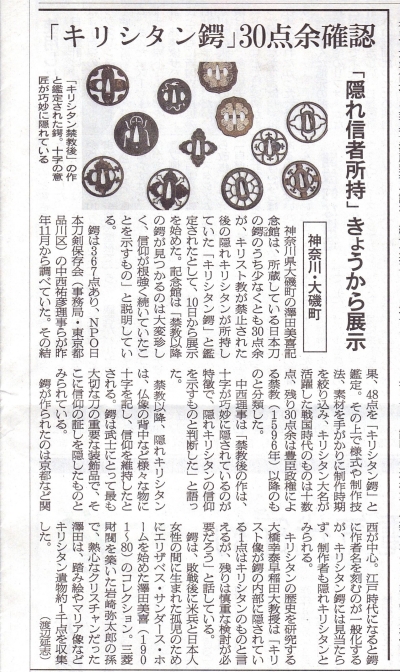Japanese feudal era sword guards might have been owned by 'hidden Christian' samurai
Several Japanese feudal era sword guards on display at a museum might have been made or belonged to "hidden Christians" at a time when Christianity was banned in Japan.
"It is extremely rare to find sword guards used after the adoption of anti-Christian policies," said an official at the Sawada Miki Kinenkan museum, as quoted by The Asahi Shimbun. "The findings indicate that they kept their deep faith (despite persecution)."

According to the report, since November 2015, Yuhiko Nakanishi, chairman of Nihon Token Hozon Kai, a nonprofit Japanese sword preservation association, had been examining the 367 sword guards owned by the museum. The materials and techniques used to make the artifacts as well as design and other factors were also considered in order to make an estimate on when they were created.

Forty-eight were identified to have belonged to Christians, and more than 10 of these could have been created somewhere between 1467 and 1568 during the Sengoku period. It was duriing this Warring States era that some warlords were believers of Christianity. The other sword guards are estimated to have been made after 1596, the year that warlord Toyotomi Hideyoshi adopted anti-Christian policies. Christians then hid their Christian faith, only expressing it by drawing crosses on different objects.
The sword guards, having been among the samurai's most the important ornaments for their swords, is believed to have been designed with hidden crosses to prove their Christianity, albeit in secret.
"A characteristic of sword guards made after anti-Christian measures were taken is that Christians carefully hid crosses in their designs," Nakanishi said. "We concluded the designs show the faith of hidden Christians."
However, Waseda University history professor Yukihiro Ohashi said that caution must be taken since it's too early make conclusions that the sword guards were actually owned by Christians.
"We can say the sword guard that has a statue of Jesus Christ inside it belonged to a hidden Christian," he said, "but others need to be carefully examined before confirming that they belonged to Christians."
The sword guards have been on display at the Sawada Miki Kinenkan museum since May 10.
 Christians don't have to affirm transgenderism, but they can’t express that view at work: tribunal
Christians don't have to affirm transgenderism, but they can’t express that view at work: tribunal Archaeology discovery: Medieval Christian prayer beads found on Holy Island
Archaeology discovery: Medieval Christian prayer beads found on Holy Island Presbyterian Church in America votes to leave National Association of Evangelicals
Presbyterian Church in America votes to leave National Association of Evangelicals Over 50 killed in 'vile and satanic' attack at Nigerian church on Pentecost Sunday
Over 50 killed in 'vile and satanic' attack at Nigerian church on Pentecost Sunday Ukrainian Orthodox Church severs ties with Moscow over Patriarch Kirill's support for Putin's war
Ukrainian Orthodox Church severs ties with Moscow over Patriarch Kirill's support for Putin's war Islamic State kills 20 Nigerian Christians as revenge for US airstrike
Islamic State kills 20 Nigerian Christians as revenge for US airstrike Man who served 33 years in prison for murder leads inmates to Christ
Man who served 33 years in prison for murder leads inmates to Christ


 Nigerian student beaten to death, body burned over ‘blasphemous’ WhatsApp message
Nigerian student beaten to death, body burned over ‘blasphemous’ WhatsApp message 'A new low': World reacts after Hong Kong arrests 90-year-old Cardinal Joseph Zen
'A new low': World reacts after Hong Kong arrests 90-year-old Cardinal Joseph Zen Iran sentences Christian man to 10 years in prison for hosting house church worship gathering
Iran sentences Christian man to 10 years in prison for hosting house church worship gathering French Guyana: Pastor shot dead, church set on fire after meeting delegation of Evangelicals
French Guyana: Pastor shot dead, church set on fire after meeting delegation of Evangelicals ‘Talking Jesus’ report finds only 6% of UK adults identify as practicing Christians
‘Talking Jesus’ report finds only 6% of UK adults identify as practicing Christians Mission Eurasia ministry center blown up in Ukraine, hundreds of Bibles destroyed: 'God will provide'
Mission Eurasia ministry center blown up in Ukraine, hundreds of Bibles destroyed: 'God will provide' Church holds service for first time after ISIS desecrated it 8 years ago
Church holds service for first time after ISIS desecrated it 8 years ago Burger King apologizes for 'offensive campaign' using Jesus' words at the Last Supper
Burger King apologizes for 'offensive campaign' using Jesus' words at the Last Supper Uganda: Muslims abduct teacher, burn him inside mosque for praying in Christ’s name
Uganda: Muslims abduct teacher, burn him inside mosque for praying in Christ’s name